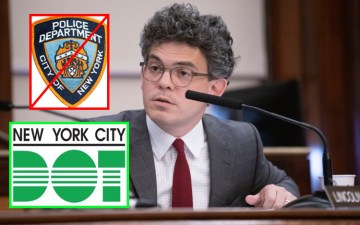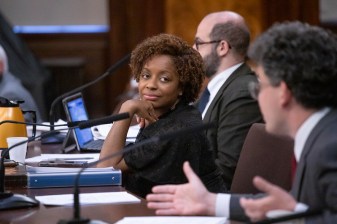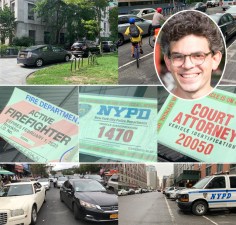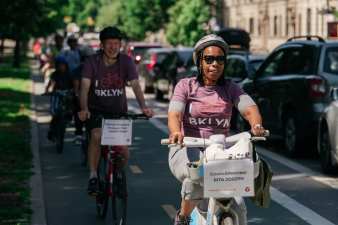DOT: We ‘Love’ Repeal of the Notorious Law that Delays Bike Lane Installation

It’s a match!
The Department of Transportation said on Monday that it was head over heels for a City Council bill that would repeal an old law mandating that the department give extra notice to a community board before it can install a bike lane.
“We love Lincoln Restler’s bill,” Transportation Commissioner Ydanis Rodriguez said at a Council hearing, throwing the Adams administration’s support behind a proposal to put bike lanes on the same community outreach and installation schedule other street projects are on around the city.
Restler, the Williamsburg Democrat, picked up then-Council Member Antonio Reynoso’s original 2021 bill, which is called Intro 417. The bill would change city law so that the DOT would no longer need to give community boards 90 days of notice before installing a bike lane and then wait until 45 days after a community board hearing to install the bike lane. Instead, bike lane proposals would move on the same timeline as other street projects that go in front of community boards, allowing the department to install a bike lane 14 days after notifying a community board that it will be installing a bike lane.
The DOT supports the bill, according to Rodriguez, because the agency’s mandate to install protected bike lanes has grown even as the number of days during its annual striping season has not.
Rodriguez also pointed out, as critics did when then-Council Member Lew Fidler created the existing law, that it’s absurd to require bike lanes, which reduce cyclist injuries by more than 30 percent, to be put on ice for 45 days even after getting community board clearance when under other city law, a “major realignment” of a street gets only a 10-day review by the local Council member and a 30-day oversight by the local community board.
“We feel that it is important to shorten the preview time for the feedback because … many other projects are not included, like open restaurant and open streets,” said Rodriguez. “And because of the work that we have got to do during the spring, the fall and the summer, by reducing this [preview] time, the bill will help the agency and the whole city to be in a better place to get the numbers of bike lane that we need in our in our city.”
The Fidler bill that added the review period for bike lanes, and only bike lanes, was imposed on the DOT at a time when every bike lane project was seen as a wild overreach, something Fidler himself said in 2011. But since then, even automobile bastions like northeast Queens have asked the city for protected bike lanes instead of paint.
Council Member Farah Louis, whose Flatbush district has no protected bike lanes, argued that the bill would remove the ability of community boards to do the, “We like bike lanes, but not these bike lanes” dance — a time-honored method of killing safety initiatives (indeed, her district and the neighboring district of Council Member Kalman Yeger were offered painted bike lane networks in 2021, yet DOT has not moved forward due to community board opposition).
A top DOT official pushed back on Louis’s argument.
“It does not take out the community board and the elected official process, it just modifies it so that we don’t have these extended waiting periods that were built into doing bike projects specifically,” said Sean Quinn, the assistant commissioner of street improvement projects. “It still involves the community and elected officials as needed. We usually do go above and beyond in a lot of these communities when we’re proposing bike infrastructure instead of just a touchpoint with the board or council member. We have our ambassadors, we have portals we have a lot of engagement that we like to do.
“It’s really important to grow the bike network in districts where we’ve seen a high number of ridership. and a high number of injuries,” he added.
Bike advocates cheered the possible end of the Fidler Rule, which Bike New York tweeted was responsible for “redundant, delay-causing notification requirements regarding bike lane projects, at a time when NYC DOT is under criticism for not meeting Street Master Plan targets.”
DOT says it supports Intro 417 (as does BNY!) The bill would increase DOT output by reducing redundant, delay-causing notification requirements regarding ? lane projects, at a time when NYC DOT is under criticism for not meeting Street Master Plan targets https://t.co/RymuhVJBFb
— Bike New York (@bikenewyork) April 24, 2023




